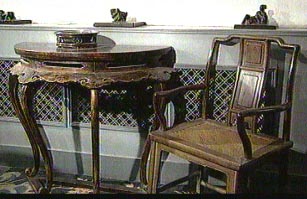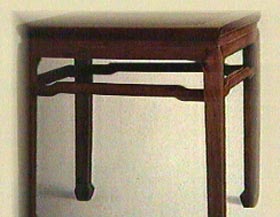Furniture is part of a convention concerning people's residence. Its design, manufacture and style reflect the spiritual outlook and aesthetic taste of a time. The Ming and Qing dynasties were the golden age of Chinese traditional furniture. It not only inherited the tradition of the previous thousands of years, but made breakthroughs. Thanks to this, it has its distinctive style.

The development of Chinese furniture is linked to changes in people's daily life. Since the Southern and Northern dynasties when Chinese people no more sat on the ground but began to sit on higher chairs, a large quantity of the high household articles like chairs, tables, stools came into use. In the Ming Dynasty, the emergence of many industrial and commercial cities accelerated the commerce and handicraft industries, and this stimulated the production of furniture.
Choice Ming-dynasty furniture is made of precious wood like pear wood and red sandalwood. Such materials not only have dark colours, fine grain and are hard and smooth, but because they have great specific gravity and do not float on water they are suitable for precise mortises and tenons and meticulous carving.

According to Wang Shixiang, specialist on classical furniture, most Ming-dynasty household articles are unadorned; they are simple. But their structure is logical;and their appearance eye-pleasing. They are in concise outlines. All successful products meet certain specifications, but they are not stereotyped. They are not so standardised as if they are cast from one mould. They are diversified. The producers give rein to their imagination. As a result, each article is well proportioned with free space. The divisions, volume, length, curves, angles, corners of each part are well weighed to the extent that you can't add or remove anything. Their forms and structures have won admiration of the international technological designers.
Entirely different from the Ming furniture, Qing-dynasty furniture is largely broad and thick. Embellished with carving, embedding and painting, it has a great variety.
Ming and Qing furniture adopts China's traditional mortise-and-tenon technique. No iron nail is used. The glue is only an accessory means. Mortises and tenons can fix everything in every side and angle. The preciseness of process and the tightness of the dovetailing is flawless. This unique dovetailing, good frame structure and the perfect shapes together make the Chinese classical furniture a combination of practical use and beauty, and of science and art.
No place has collected more Ming and Qing furniture than the Palace Museum in Beijing. Over the long history, the most precious household articles and art works have flowed here from different parts of China.
Thanks to its ingenious conception, logical structure, unique style and the profound cultural information contained in it, Ming and Qing furniture has become part of the cream of Chinese civilization.





